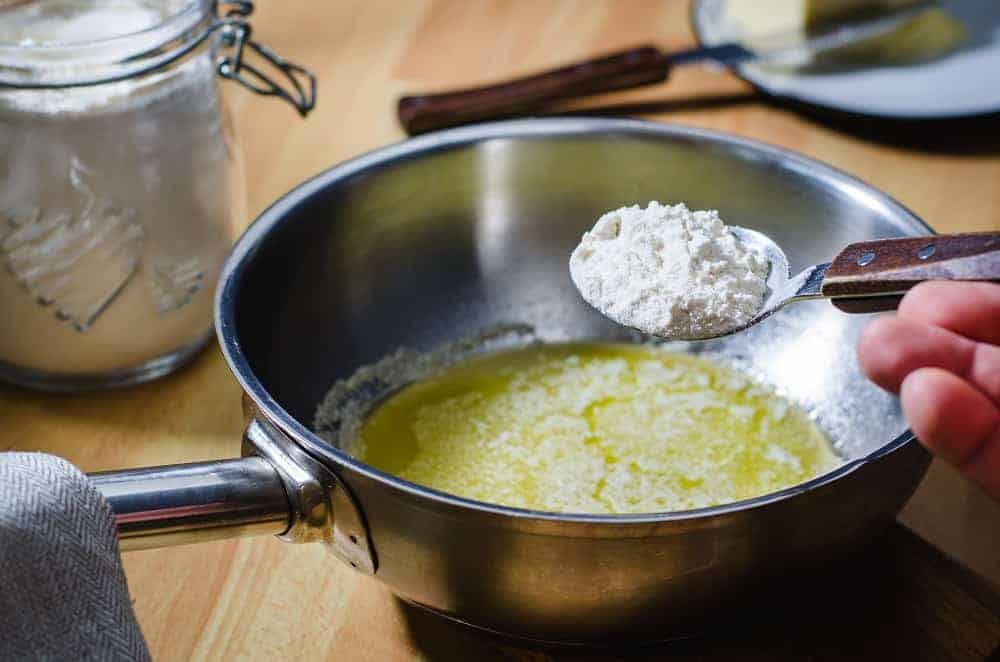This post may contain affiliate links. See my privacy policy for details.
Certain cooking terms seem to crop up repeatedly in all kinds of different recipes. These confusing terms often leave would-be cooks bewildered and unsure of what they are supposed to do.
One question that frequently emerges is how to make a roux.
Whether you are asking how to make a roux for gumbo, or how to make a roux for gravy, it seems like something that only fancy French chefs know how to do.
However, it is actually super simple if you know what to do. So, how do you make a roux?

What Is a Roux?
To be able to make a roux, you first need to understand what a roux actually is.
A roux is essentially a mixture of fat and flour cooked together, which aids in thickening sauces and soups.
The chemistry behind a roux is that, when heated, flour releases starches that were previously trapped within the cell walls of the wheat. By making and cooking a roux before adding it to the dish, the starches separate and the flour cooks, contributing its thickening power while also offering plenty of tasty, cooked flour flavors.
Of course, like all things related to cooking, it can get a lot more complicated than that.
While a simple roux is basically just fat and flour heated up, there are a variety of different variations, depending on what you want to do with it.
A regular roux is commonly called a light or white roux, but you can also get a dark roux. These require you to cook the flour far more than you would normally, taking it from a regular white color all the way to a blond or even a black.
For example, many Cajun foods require making an incredibly dark roux, which most people think of as burning.
Something to keep in mind, though, is that the darker your roux gets, the less thickening power it has.
You can also make roux incredibly simple if you are in a rush but at the cost of some flavor. So, how do you make some roux, depending on what kinds of roux you want?
How Do You Make All The Different Types of Roux?
To make a really basic, white roux, you first need to get your hands on some fat.
Most typical French cuisine would use butter, but if you were making meat gravy, for example, to go over a roast, you could easily use the rendered fat from your roast.
Regardless of your precise fat choice, you will need about a quarter cup of liquid fat. You then need to melt your fat to get it ready for the roux. Heat it gently over a low flame until just bubbling and sizzling.
After this, add an equal amount of flour by volume, usually another quarter cup. Whisking constantly with a thin wire whisk, you want to get the flour incorporated and avoid it scorching on the bottom of the pan. Probably best to avoid cast iron pans for this!
As the flour cooks in the fat, the starches get released, as well as the excess water from the fat. This allows the flour to caramelize, giving it incredible flavor as it deepens in color.
After about three to five minutes, depending on how dark you want your roux, you can then take it and use it in your recipes.
If you want to make a darker roux, you need to cook it a lot longer! Some Cajun recipes cook their roux for up to forty-five minutes! It requires constant stirring and careful attention to ensure it doesn’t brown.
There is also the Singer method of making a roux, whereby you just add your flour directly onto your cooking vegetables when making a soup. The fat you already used to cook the ingredients stops the flour from clumping, while also mixing with all the juices in the recipe. You can then just add your regular liquid ingredients after your Singer roux has cooked sufficiently.
If you are in a massive hurry, you could also make flour and cold water mixture and use that, hoping that the heat from your soup or sauce will be enough to release the starches from the flour. This is called a ‘cowboy’ roux, and it comes with a lot of sort of nasty raw flour flavor.
One final method is a particularly interesting method known as a Beurre Manie, which literally means kneaded butter. You simply knead together equal parts of butter and flour until sticky, supple ball forms.
Adding this to sauces and stews thickens the mixture, while also contributing a super smooth texture and not creating disgusting flour particles.
So, once it is all cooked, how do you actually use your roux?
How Do You Use a Roux?
Roux is used to thicken sauces and soups, and you have a couple of different options to choose from when choosing to incorporate them into your dish.
You can either add the cooked roux into your sauce or soup near the end of cooking or put it at the beginning.
To use at the end, simply scrape your cooked roux into the recipe and stir vigorously, allowing the flour and butter to disperse and thicken over the next five to ten minutes.
To use it at the beginning, you can actually just build the recipe from the roux, to begin with. This is commonly done with sauces like béchamel; just make it, then add in the milk for the recipe slowly, constantly whisking until dissolved, then go from there.
Making and using a roux is incredibly simple once you know how to do it; it just requires a little knowledge and a little bit of practice.
Also, a few practice runs. Don’t worry; everyone burns their first one.












Leave a Comment or Recipe Tip